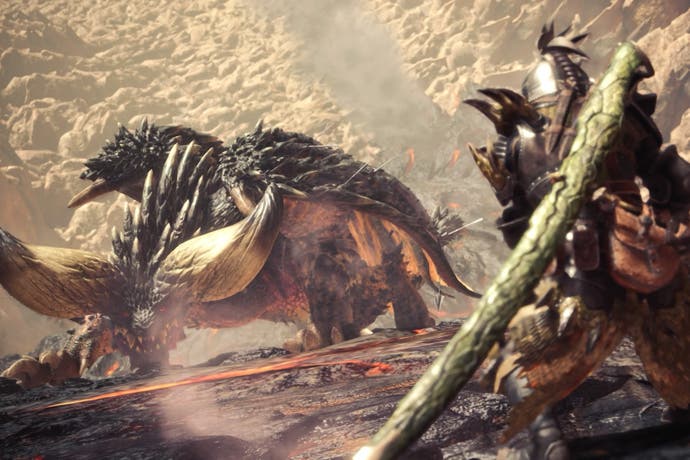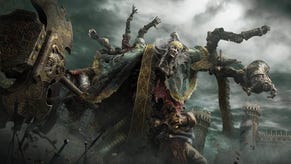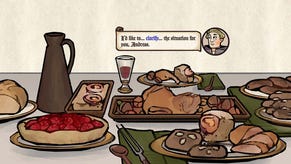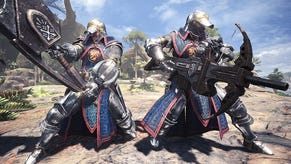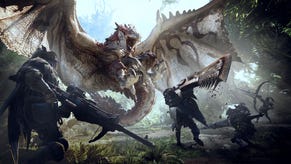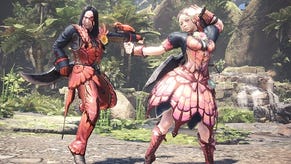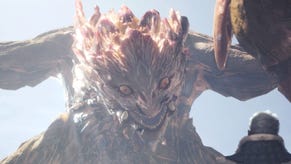Monster Hunter World tips to help you excel in the hunt
Here's when to farm, what to forage and things you should do between hunts.
Monster Hunter World is the most forgiving entry to date, but that's not to say everything is straightforward. Combat, quests, materials and upgrades all have their quirks, and it's only you put a handful of hours into it that things start to really come together.
To help, here's a list of Monster Hunter World tips you should be doing or taking notice of as you progress through the Hunter Ranks.
If you're after the essentials, our Monster Hunter World walkthrough and guide can help break down what a hunt entails step-by-step, as well as the variety of activities you can get up to outside main story missions - which we also list in order to help you decide when to push on to a specific monster you want to carve into fancy armour.
Try a range of weapons to see what works for you
There are 14 weapon types to choose between - from swords to bows, and even musical bagpipes and insects - so it's worth swapping them round between early hunts to get a feel for something you like.
The game recommends a series of 'beginners' weapons - as broken down in our Monster Hunter World weapons list - which are no less powerful than other types, but are simply easier to get your head around initially.
Guides Editor Matt is still clinging onto his Dual Blades - they're quick and have a 'charge' mode to do a quick bout of extra damage - while reviews editor Martin evangelises the powerful but slightly unwieldy Hammer. Essentially, go with whatever works for you.
Whatever you decide, you own a basic 'Iron' variant of each weapon, and each one is easy enough to upgrade a few times if you want to try something new later - so don't think you're hemmed in once you invest in a certain branch of the weapon tree.
You'll need to sharpen your weapon frequently
Something that is essential but not immediately obvious is your weapon will blunt over the course of a hunt and do less damage, as indicated by the weapon meter in the top left corner. (Yes, even hammers will become 'blunt' over time, oddly enough.)
To sharpen weapons, go through your inventory (hold L1 or the left bumper then left or right) and select Whetstone - it's always in there, so don't worry about having to pack it before you visit - then press Square (or X on Xbox) to let the animation play out.
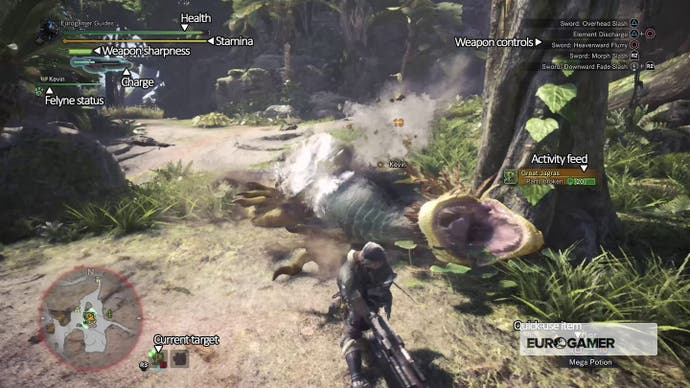
Doing so leaves you open for attack, so we'd recommend sharpening whenever the monster is distracted, or ideally, fleeing to another area.
Bonus tip - if you are mid-hunt and Scoutflies suddenly appear, the monster will run away a few seconds later. This means you can relax momentarily, use a Potion or Whetstone, then give chase.
There's no character level, but there's plenty to upgrade
Your character doesn't have a level as you would with a traditional role-playing game - your equipped armour and weapon dictate your defence and offence - but there's all sorts to update as you go.
Monster encounters - whether it's completed hunts or simply finding tracks - increase your Ecological Research and overall Research points; completed missions increase your Monster Rank, allowing you to tackle harder missions; and your Palico and Tailraiders both level up as you play.
In short, the more hunts you complete, the higher these ranks go, so it always feels like you're progressing towards something, but it's weapons and armour you'll always need to want to tinker with to get more powerful.
Do two things before every hunt
Before you run off into the wilderness in search of your prey, remember to do two things. One, check the Supply Box to get a supply of free Potions and sometimes a selection of mission-specific goodies.
Two, prepare yourself a meal. Unlike previous games you can do this at the camp when you load into an area at the start of a mission. Doing so will give you stat bonuses which can give you a real edge in battle.
Though you can create your own meals, to make it easy, just select one with stat bonuses you'd like (defence is always best for new encounters) and go from there.
Bonus tip - make sure you're always loading into a hunt with the essentials before you load into them, such as a stock of Mega Potions, Antidotes, as well as a Shock Trap and some Tranq Bombs, so you can choose to capture a monster at any time - which gives you bonus resources compared to a standard kill.
Scoutflies make tracking monsters easy
New to Monster Hunter World, Scoutflies are a green breadcrumb trail that leads you to whatever monster is lurking out in the world.
You'll need to do some legwork first. Run around and find monster markers - footprints, skidmarks, feathers and so on - which give the Scoutflies the scent. After enough, you can then follow the trail.
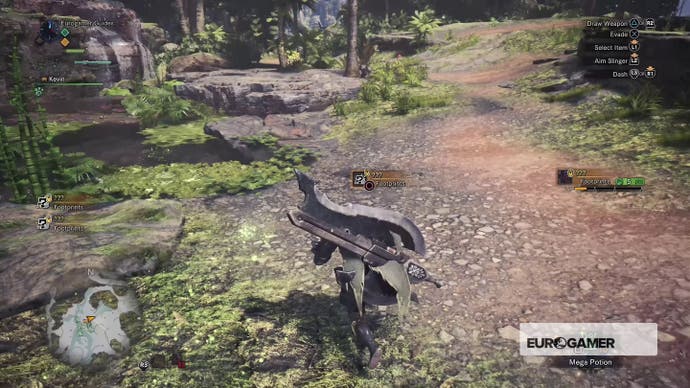
If you lose your creature, all you then need to do is open your map, move the icon to the bottom left to tag it. You can also select non-monster items on the map to get a guide to their locations, too.
Note even if you have levelled up research for a particular monster and want to track it in a later quest, until a certain research level you'll still need some footprints first - but the trail should show up much quicker than before.
Collect everything you see - even if in a rush
As you explore each area, you'll encounter lots of things to investigate or collect - from monster footprints, skidmarks and feathers, to plants, mosses and insects to scavenge.
You'll want to investigate everything you see; markings are essential in tracking monsters (even for creatures you're not after right now) and give you easy Research points; ores and bone piles further unlock upgrade trees and will always come in handy at some point, and any bugs, plants and other consumables can be sold or crafted into more useful things.
There's a lot out there, and thankfully, you can pick up everything at a sprint. Even if you are chasing a wounded monster and pass over some footprints, just tap Circle (or B on Xbox) and you'll 'collect' it without even skipping a beat.
But don't stress over every system
Even though you should grab everything, don't worry if you can't see a use for something you find or the game gives you a tutorial for.
Monster Hunter is full of all kinds of items and adjoining systems - fish for fishing, plants for crafting, countless ammo types for bows, and experience points rewarded for all kinds of things.
If it feels overwhelming, think of it like a more traditional role-playing game such as Skyrim, where there's items and systems to cater for every 'role' the player might want to choose - from those serious about cooking meals to projectile-wielding gunners - but you can feel free to ignore those and still get what you want from the game.
Just want to batter some monsters? Then pick a weapon, stock up on Potions, choose the Assigned missions and go from there. Then if a side-quest or system takes your interest, you can then dip a toe in when you want a break from the main story.
Take your time with new monsters
Though there are certain rules you'll want to follow in combat - to avoid tackling beasts from the front, always keeping moving - each one has its own traits and tenancies.
Each first encounter will be relaxed in terms of time limit, so use the opportunity to survey. Be distant, observe behaviours and work out how the best ways to attack before getting stuck in.
It's better that then fainting and having to send minutes running all the way back to a far-flung area. But if you do fail, don't get too stressed out - getting knocked back and then eventually succeeding is all part of the fun.

Don't worry about farming monsters for materials to start with
When you first arrive in the game's opening Ancient Forest area, we'd recommend taking down and carving Jagras for a basic armour set, then investigating ores and bone piles for quick and easy weapon upgrades.
Both of these can be done as you perform standard quests, while ores and bones are the starting point of every weapon tree, so it's worth getting on the ladder early.
These basic upgrades will last you well several encounters into the game's second area, Wildspire Wastes - at which point, you'll come across monsters who offer better 'value' materials if you choose to farm.
You don't need to too grind much in the main story
There are spikes with certain monsters, by and large you don't need to do many side-quests or investigations if you want to crack on with the main Assigned missions.
You should still keep upgrading your armour and weapons though - again, the branches for just ores and bones allow you to forage materials instead of carving them for certain upgrades, plus individual armour pieces from the smaller creatures make for quick kills.
As long as you're always upgrading whatever you can along the way, you shouldn't have to spend hours farming for materials.
Of course, if you are worried you need to upgrade at some point, the rule of thumb we found was when it becomes too difficult to beat an Assigned monster, then it's time to visit the Smithy, or consider farming.
...but mastering and farming a single monster is incredibly rewarding
That said, we would recommend taking the time to delay story progression when you can to farm materials from a single animal.
Doing so can get you a complete armour set for that creature. Unlike, say Destiny, where loot sources can be quite obscure, in Monster Hunter World it's thankfully a case of just killing the creature the armour set belongs to to get what you need.
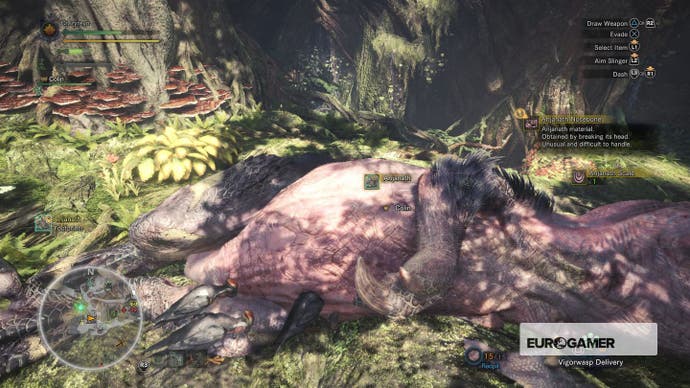
Not only that, but the process of mastering one particular monster is really satisfying. And in the case of something like an Anjarath that's been causing you bother for so long, it's an remarkably cathartic process.
New armour not only give you better defence stats, but each piece of armour adopts the appearance of the creature you've taken it from. The armour crafting screen can give you a preview before you put the time into hunting - who wouldn't want to model themselves after a fluffy white Paolumu?
Expeditions are worth doing - just don't hunt monsters there
Expeditions allow you to load into any area without a hunt active, by selecting a region you've explored from the World Map. These allow you to explore and forage at your own pace and find additional sidequests, such as finding Grimalkynes.
Though monsters will roam around, you cannot predict which ones will appear, so the most efficient way to hunt a specific type is via Investigations (which can be picked up at Resource Center).
That way your chosen monster will reliably spawn, give you bonus materials as a quest reward, and top up your supply Armour Spheres to strengthen your equipment.
There's all kinds of other quest types on the quest board and in the Resource Center - our Monster Hunter World walkthrough and guide explains the differences between them.
Use small creatures to your advantage
As you fight, you may notice insects you can interact with. These can give you health or trigger status effects if you activate them.
The healing Vigorwasp is a dependable favourite, and you can kick paralysing yellow toads to give a monster a shock. So if you're up against the ropes, keep an eye on these creatures to give you a little respite.
And when you're not in the heat of battle, you can capture them too.
Return to town after every mission
As you play you'll soon learn the checklist of things to check in on after every hunt.
It's worth visiting the Resource Centre (to Register any new Bounties and Investigations, as well as Complete Deliveries), see the Smithy to work out if any new materials have opened up any new upgrade branches, check off any Question Marks on the map to pick up new quests, and regularly clear out your inventory so you don't run out of room mid-quest.
It's also worth doing an Expedition into a newly unlocked area to pick up any location-specific quests, too.
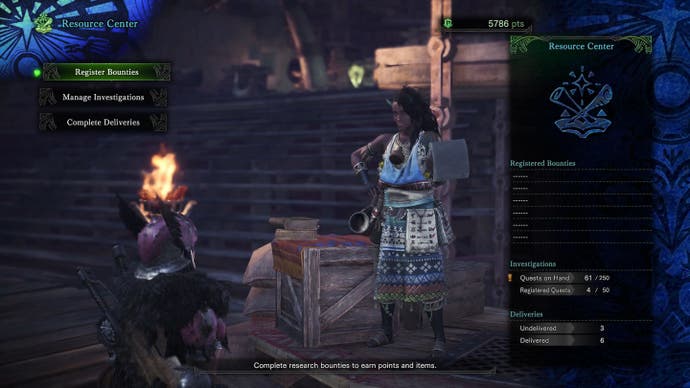
You can play entirely solo, but working with friends is fun - just be aware of online's foibles
Hunting with up to three other players is where Monster Hunter shines, though it can be a little fussy to work out.
For one, Assigned missions won't allow players to join you until you've played all the cutscenes in that mission - but it's fair game for friends to join when it's over.
If you're stuck mid-hunt, you can send out an SOS call for other players to join you mid-hunt, but it's worth assembling a team to take on monsters together from scratch.
The difficulty will increase in any multiplayer session - whether it's two players and two Palicos, or just four players - to compensate for the extra help, but you have the benefit of everyone using different weapons and strategies to distract and take down your prey.
Also, don't worry about sharing loot - everyone can carve and get rewards, so it's no less efficient than solo farming.
Our how to join friends, join Squads in multiplayer page can explain step-by-step how to play with others.
Play every day for free tickets
An easy one to miss is the chance to receive a free Ticket each day, which you can 'bet' on a quest of your choice to double the amount of Zenny (money) you receive.
You have to collect these manually by pressing Triangle (or Y on Xbox) in Astera to pick it up. Note you can only hold five Tickets at once - so be sure to spend them regularly.
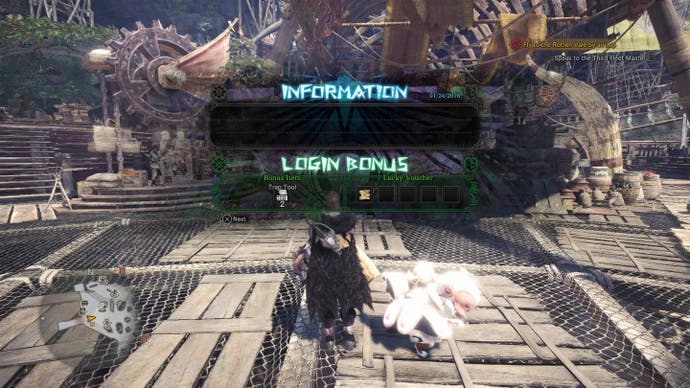
Don't sweat character customisation too much
If you're like us and you agonised over the look of your hunter in Monster Hunter World's stunning character creator, there's a few things to bear in mind.

One, you can change certain aspects (hair style, hair colour, facial hair and makeup) at any time from the Item Box in your room back in Astera. You can also get a Character Edit Voucher as DLC, allowing you to change everything else if you like.
Note only the first use is free - you can download direct from PSN and Xbox Live - but after that, it costs extra.
Second, once you've covered your hunter in fancy monster garb, you won't really see what they look like anyway.
